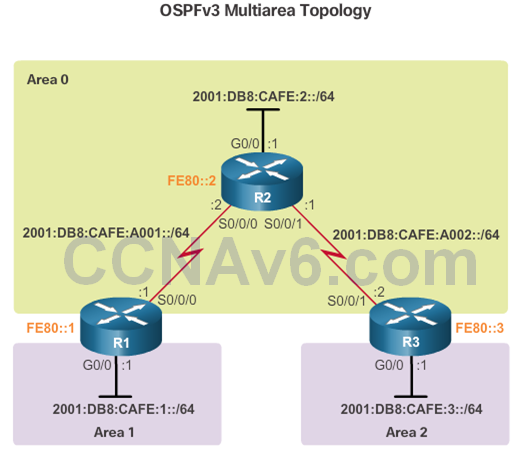Chapter 9 – Sections & Objectives
9.1 Multiarea OSPF Operation
Explain how multiarea OSPF operates in a small to medium-sized business network.
9.2 Implement Multiarea
Implement multiarea OSPFv2 and OSPFv3.
9.1 Multiarea OSPF Operation
Why Multiarea OSPF?
- Single-Area OSPF
- If the routes are not summarized, the routing table can become very large.
- Each router must maintain detailed information about every network in the routing domain.
- Multiarea OSPF
- Smaller routing tables
- Reduced link-state update overhead
- Reduced frequency of SPF calculations

- OSPF Two-Layer Area Hierarchy
- Backbone (Transit) area and Regular (Non-backbone) area
- Types of OSPF Routers
- Internal router
- Backbone router
- Area Border Router (ABR)
- Autonomous System Boundary Router (ASBR)


Multiarea OSPF LSA Operation
- OSPF LSA Types
- Individually, they act as database records and provide specific OSPF network details. In combination, they describe the entire topology of an OSPF network or area.

- OSPF LSA Types
- Type 1 – Contains a list of the directly connected interfaces, link types, neighbors, and link states.
- Type 2 – Contains the router ID and IP address of the DR, along with the router ID of all other routers on the multiaccess segment.
- Type 3 – Used by ABRs to advertise networks from other areas.
- Type 4 – Identifies the ASBR and provides a route to it.
- Type 5 – Describe routes to networks outside the OSPF routing domain.

OSPF Routing Table and Types of Routes
- OSPF Routing Table Entries
- O – Indicates the route is intra-area.
- O IA – Indicates a summary LSA.
- O E1 or O E2 – Indicates an external LSA.
- OSPF Route Calculation
- Each router uses the SPF algorithm against the LSDB to build the SPF tree. The SPF tree is used to determine the best path(s).

9.2 Configuring Multiarea OSPF
Configuring Multiarea OSPF
- Implementing Multiarea OSPF
- The type of OSPF implementation chosen depends on the specific network design requirements and existing topology.
- A router simply becomes an ABR when it has two network statements in different areas.

Verifying Multiarea OSPF
- Verifying Multiarea OSPF v2
- The same verification commands used to verify single-area OSPFv2 also can be used to verify the multiarea OSPF topology.
- For the equivalent OSPFv3 command, simply substitute ip with ipv6.
- Verify General Multiarea OSPFv2 Settings
- Use the show ip protocols command to verify the OSPFv2 status.
- The Routing for Networks section identifies the networks and their respective areas.
- Verify the OSPFv2 Routes
- The most common command used to verify a multiarea OSPFv2 configuration is the show ip route command. Add the ospf parameter to display only OSPFv2-related information.
- Verify the Multiarea OSPFv2 LSDB
- Use the show ip ospf database command to verify the contents of the OSPFv2 LSDB.
- There are many command options available with the show ip ospf database command.
- Verify Multiarea OSPFv3
- Like OSPFv2, OSPFv3 provides similar OSPFv3 verification commands.

9.3 Chapter Summary
Single-area OSPF is useful in smaller networks but in larger networks multiarea OSPF is a better choice. Multiarea OSPF solves the issues of large routing table, large link-state database, and frequent SPF algorithm calculations.
The main area is called the backbone area (area 0) and all other areas must connect to the backbone area. Routing still occurs between the areas while many of the routing operations, such as recalculating the database, are kept within an area.
There are four different types of OSPF routers: Internal router, Backbone router, Area Border Router (ABR), and Autonomous System Boundary Router (ASBR). A router can be classified as more than one router type.
Link State Advertisements (LSAs) are the building blocks of OSPF. This chapter concentrated on LSA type 1 to LSA type 5. Type 1 LSAs are referred to as the router link entries. Type 2 LSAs are referred to as the network link entries and are flooded by a DR. Type 3 LSAs are referred to as the summary link entries and are created and propagated by ABRs. A type 4 summary LSA is generated by an ABR only when an ASBR exists within an area. Type 5 external LSAs describe routes to networks outside the OSPF autonomous system. Type 5 LSAs are originated by the ASBR and are flooded to the entire autonomous system.
OSPFv2 routes in an IPv4 routing table are identified using the following descriptors: O, O IA, O E1 or O E2. Each router uses the SPF algorithm against the LSDB to build the SPF tree. The SPF tree is used to determine the best paths.
There are no special commands required to implement a multiarea OSPF network. A router simply becomes an ABR when it has two network statements in different areas.
An example of multiarea OSPF configuration:
R1(config)# router ospf 10 R1(config-router)# router-id 1.1.1.1 R1(config-router)# network 10.1.1.1 0.0.0.0 area 1 R1(config-router)# network 10.1.2.1 0.0.0.0 area 1 R1(config-router)# network 192.168.10.1 0.0.0.0 area 0
Commands that are used to verify OSPFv2 configuration consist of the following:
show ip ospf neighbor show ip ospf show ip ospf interface show ip protocols show ip ospf interface brief show ip route ospf show ip ospf database
To use the equivalent OSPFv3 command, simply substitute ip with ipv6.
Download Slide PowerPoint (pptx):
